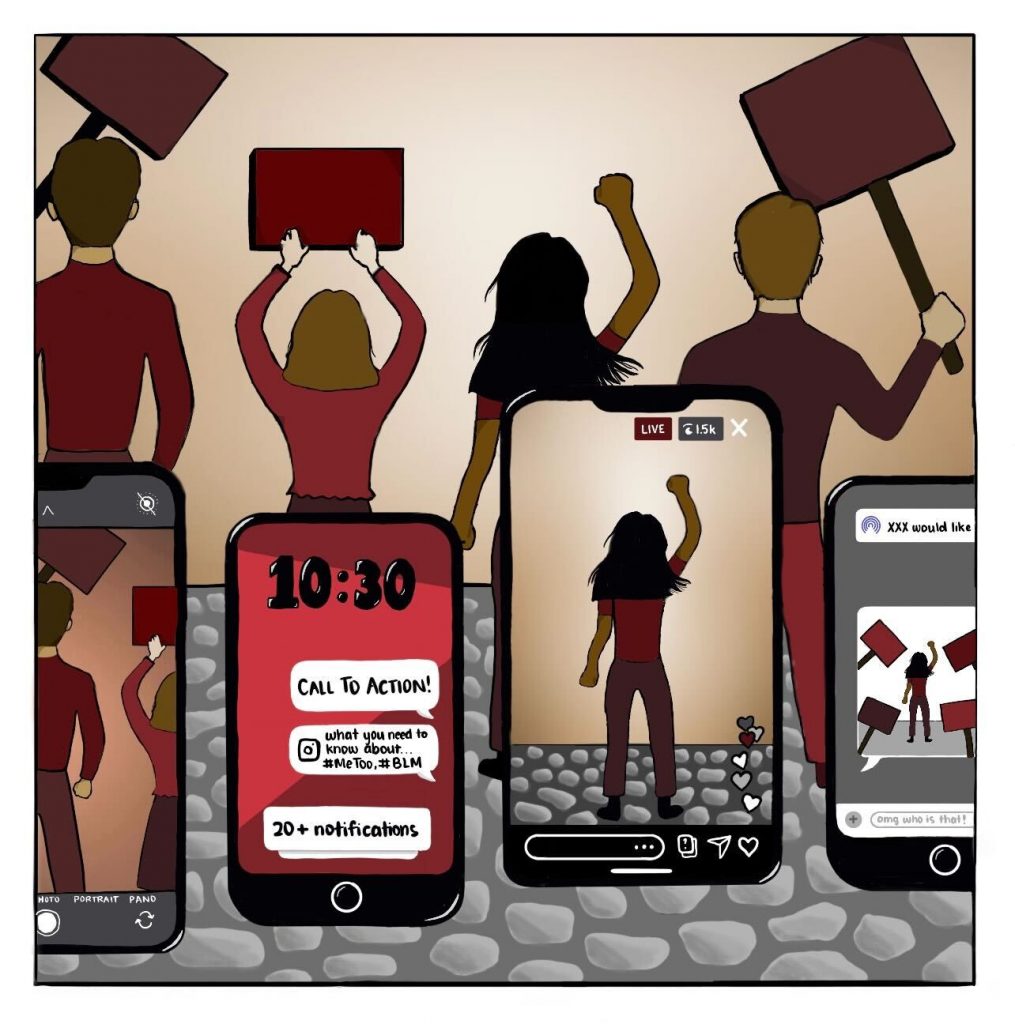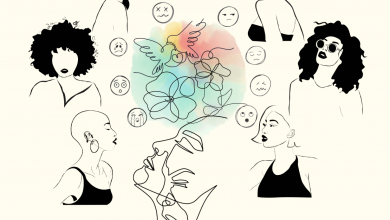Revolution Will Be on IG Live: Reflections on Online Activism
Image Description: Activists are standing with their backs toward us, and phones are behind them, recording what they are doing.
“You will not be able to stay home, brother.
You will not be able to plug in, turn on, and cop out.”
— Gil Scott-Heron, The Revolution Will Not Be Televised
Gil Scott-Heron’s “The Revolution Will Not Be Televised” was a warning, promise, and challenge. Written in the early 1970s, it was a direct call-out to those waiting for change to simply appear on their screens. Revolution, he argued, was something you had to be part of — it wasn’t a spectacle you could watch from the couch. Yet, fifty years later, we now have a world where revolution is, quite literally, on-screen. It’s not just televised; it’s live-streamed, clipped into infographics, hashtagged, and transformed into viral challenges.
But there is something to learn about those previous warnings — the question now repackaged: Is today’s digital activism bringing us closer to real change, or has it become a curated performance?
From the Streets 2 the Screens
Before the internet, activism was mostly determined by physically showing up. The civil rights movement relied on mass sit-ins, boycotts, and organized protests that took months — even years — of planning by a web of different organizations. The 1963 March on Washington was not a spontaneous demonstration, it was the product of deep organizing, coalition-building, and a commitment that went beyond a single moment of visibility. Compare that to 2020: The murder of George Floyd sparked one of the largest protests in modern history, with demonstrations in all 50 states and across the world. Social media played a crucial role in spreading information, a butterfly effect that started from Darnella Frazier’s phone and led to countless protests and fundraisers. Organizers could now reach thousands of people within hours by providing real-time updates on police movements, legal resources, and donation links. While the speed and scale of digital activism are unprecedented, they also come with new challenges. Movements today may go viral overnight, but they might fade just as quickly. Traditional activism requires long-term strategy; for all its power, social media activism is often at the mercy of an algorithm that prioritizes engagement over sustainability.
Power / Fragility
Social media has undeniably changed how we show up for causes. Activism is no longer limited to who can physically be in the streets — an important shift for people facing barriers such as disabilities or chronic illness, for whom in-person protests were previously inaccessible; online activism’s accessible nature has allowed for more inclusivity. At the same time, digital activism is fragile. Social media platforms are not neutral spaces — they are corporations designed to maximize engagement. Instagram and Twitter/X can amplify movements, but they can also silence them. The latter process may be achieved through shadowbanning, content removal, and the suppression of certain hashtags. Activism that depends entirely on social media is always vulnerable to being buried or erased.
There’s also the issue of speed versus depth. The internet makes activism fast: a viral post can educate thousands in minutes. But does fast activism mean effective activism? As political education gets gradually reduced to pre-made Instagram slideshows from progressive info pages such as “Impact” or “So.Informed,” reposting the infographic starts to feel like enough activism by itself. But then, are we building real change or just checking a box?
The 2020 Black Lives Matter movement, #MeToo, and similar social initiatives demonstrated both digital activism’s strengths and limits. While online mobilization contributed to massive turnouts and millions in donations, the movement also saw a sharp drop in engagement after a few months. Think back to the black squares that some people posted on Instagram as part of #BlackoutTuesday. Not only did many people consider it to be counterproductive by slowing down the information flow and support, but it was often performative, as it was not followed up with any further action. This highlights the paradox of Instagram activism: While it can mobilize people with good intentions, it can also create an illusion of progress without real structural change.
Stand for Something or Die in the Morning (s80, HP)
The phrase “if you don’t speak up, you’re complicit” has become a defining feature of modern activism. The expectation to take a public stance on every major issue is now embedded into online culture. This applies not just to celebrities and influencers but to regular people as well. In the digital age, silence is interpreted as indifference. But does sharing something online actually mean you stand for it? Or does it just mean you don’t want to be seen as the person who didn’t post?
This is where the line between activism and social reputation starts to get blurred. It wouldn’t be absurd to say that most people genuinely care about the issues they post about, but there’s also a very real pressure to be visibly engaged that may lead them to be performative. In such a context, (online) virtue signaling becomes a problem: those who raise awareness via their online platform feel qualified to judge others solely based on how they’ve used their platform. When a major social issue dominates the timeline enough to break through every echo chamber, not interacting can feel like a statement in itself. Due to this, people sometimes post not because they are deeply invested in an issue, but because not posting feels like a bigger risk to their social reputation.
This expectation is even stronger for celebrities. Every time a major crisis occurs, people flood the comments of influencers and public figures, demanding, “Why haven’t you spoken up about this yet?” This push for celebrities to become activists reveals much about our expectations and parasocial relationships with them. It’s a double-edged sword: while celebrities may have significant social and economic influence that could create meaningful change, their statements often feel hollow — just another way to maintain their brand or appease the guilty conscience of their fans. Frankly, does yet another vague statement or Instagram story from an out-of-touch celebrity matter? I’d much rather listen to the voices of those directly affected by injustice and learn how I can help than sit through Adrien Brody’s drawn-out speech about stopping hate.
That said, I don’t believe celebrity activism should be dismissed entirely. Figures like Colin Kaepernick have shown that when celebrities commit to a cause with genuine intention and sustained effort, their influence can spark powerful conversations and real change. There’s value in using a platform for good, but this engagement must go beyond performance. Even for everyday users, there’s a fine line between advocacy and performative activism. Activism has become a kind of social currency — a way to show you’re “on the right side.” Sharing infographics or posting hashtags can feel like contributing, but does it create change?
While spreading awareness can be helpful, it often stops there—it’s more about appearances than action. The question is: Does this kind of engagement lead to real impact, or just the illusion of caring? Maybe that’s the lesson: caring should be less about what’s seen and more about what’s done.
Types of Online Activism
Not all digital activism is created equal. According to Sandor Vegh, there are three main types:
1. Active/Reactive Activism: Some activism is proactive, working toward long-term change. Other times, it’s reactive: responding to immediate crises. Much of Instagram activism falls into the latter category. #BreakingNews
2. Organization/Mobilization: This is where social media truly shines. Whether it’s coordinating protests, mutual aid funds, or spreading information, platforms like Instagram can be effective organizing tools.
3. Awareness/Advocacy: This refers to reposting, infographics, and viral tweets. Awareness is crucial, but if it doesn’t lead to real action, it risks becoming hollow.
Understanding these categories helps us recognize where our efforts fit and how to make them more meaningful.
Beyond Performative Activism
I consider activism to be a form of perpetual learning that forces us to question the systems that surround us. Now, I consider Gil Scott-Heron’s poem to be a challenge about how we show up for the change we may passively desire.
Those who want change, no matter how much they wish for it to happen naturally, cannot simply watch it happen. We have to participate. That was true in the 1970s and remains true today. Social media is a powerful tool, but it is also just that — a tool. Raising awareness is important, but it’s only the first step. If we want real change, we need to pair digital activism with real-world action.
For instance:
Instead of just sharing donation links, donate if you can.
Instead of just posting about protests, show up when possible.
Instead of only spreading information, make sure you’re educating yourself beyond social media soundbites.
No matter how “naive” it sounds, activism should always be about wanting the world to be better tomorrow by taking action today. It starts with mindfulness and being aware of the barriers that prevent people from participating, building accessibility in the process. Making resources easier to understand, ensuring actions are inclusive for disabled people, and creating entry points for those who might feel overwhelmed or intimidated. The goal would be to make meaningful change easier for everyone to join in, whether digitally or on the ground.
And at the end of the day, the revolution won’t just be on Instagram Live. It’ll be in the streets, in the books that push you to think from a new perspective, in the tents that rise in the spring, in the policies we demand, and in the ways we refuse to look away. That’s the kind of action that doesn’t disappear when the feed refreshes.





